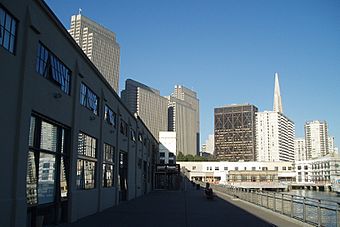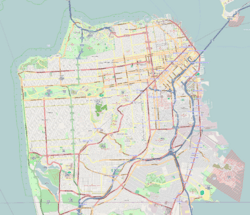Central Embarcadero Piers Historic District facts for kids
Quick facts for kids |
|
|
Central Embarcadero Piers Historic District
|
|

View of Pier 1 with Downtown San Francisco in background
|
|
| Location | Piers 1, 1½, 3 and 5, The Embarcadero San Francisco, California |
|---|---|
| Area | 6.6 acres (2.7 ha) |
| Built | 1918 |
| Architectural style | Beaux Arts |
| NRHP reference No. | 02001390 |
| Added to NRHP | November 20, 2002 |
The Central Embarcadero Piers Historic District is a special historical area in San Francisco, California, United States. It includes Piers 1, 1½, 3, and 5. This district is one of the biggest groups of old piers still standing along San Francisco's Embarcadero. The Central Embarcadero Piers Historic District was added to the National Register of Historic Places on November 20, 2002. This means it is recognized as an important historical site.
Contents
Building the Piers: A Look at Their Design
The piers at Embarcadero were built over ten years. Frank G. White, the Chief Engineer for the State Harbor Commission, led this big project. Piers 1, 1½, 3, and 5 officially opened in 1918.
These piers were designed in the Beaux-Arts architecture style. This style is known for its grand, formal look. It is similar to the famous Chelsea Piers in New York City. The buildings at the front of the piers are two stories tall. They are covered in stucco and have large, two-story arches.
Behind these main buildings are the working parts of the port. These include the long piers themselves and the transit sheds. These sheds are large buildings where goods were loaded and unloaded from ships. They were built with strong steel and timber frames. Open areas around them allowed for easy movement of goods and people.
Early Days: How the Piers Helped California Grow
These piers were very important for trade within California. They were the main place for inland trade and transport in the Port of San Francisco. They helped connect San Francisco with communities in the Sacramento and San Joaquin Valleys.
This connection helped California's farming business grow. It made the state very rich. The Delta King and Delta Queen were famous boats that traveled between San Francisco and Sacramento. They offered overnight trips from Pier 1½. This made Pier 1½ a key entry point for people traveling into the state's interior. Piers 3 and 5 mainly handled freight shipping. Many companies used their office and warehouse spaces. They also used the huge transit sheds that stretched over 700 feet (212 meters) along the piers.
World War II: The Piers Go to War
During World War II, the San Francisco waterfront became very important. It was a major military hub for the Pacific theater. Troops, equipment, and supplies were sent from here to support the war effort.
Almost every pier and wharf was used for military activities. Troop ships and naval vessels were docked all along the Embarcadero. For a short time, from 1941 to 1942, antiaircraft guns and searchlights were set up at the piers. The United States Coast Guard, the Immigration and Naturalization Service, and the Maritime Service Enrolling Office all used Pier 5.
Modern Times: New Life for Old Piers
After World War II, many piers were not used as much. Other ports in Oakland, Alameda, and Richmond were better set up for new shipping methods like containerization.
However, Piers 1½ and 5 were given new life. The old Passenger Waiting Room at Pier 1½ became an architect's office. The front buildings of Piers 1½ and 5 were turned into professional office spaces. Many piers were torn down, but Piers 1½, 3, and 5 remained. They are still very visible from the Ferry Building and Market Street.
In 2001, a company called Pacific Waterfront Partners, LLC was chosen to redevelop Piers 1½, 3, and 5. Their plan is to keep the historic maritime design of the waterfront. They also want to make it easier for the public to visit and enjoy this beautiful and historic area.
![]() This article incorporates public domain material from websites or documents of the National Park Service.
This article incorporates public domain material from websites or documents of the National Park Service.




